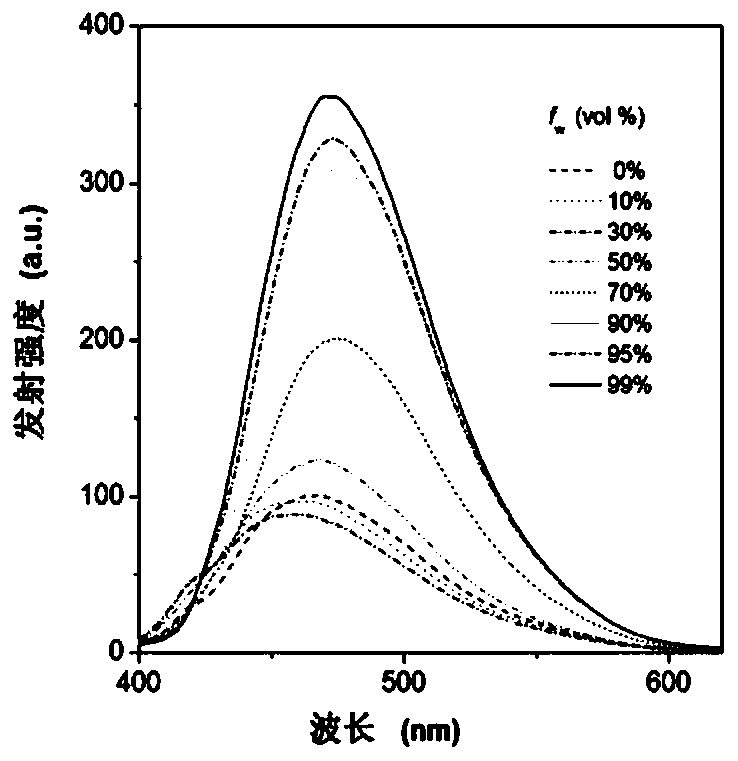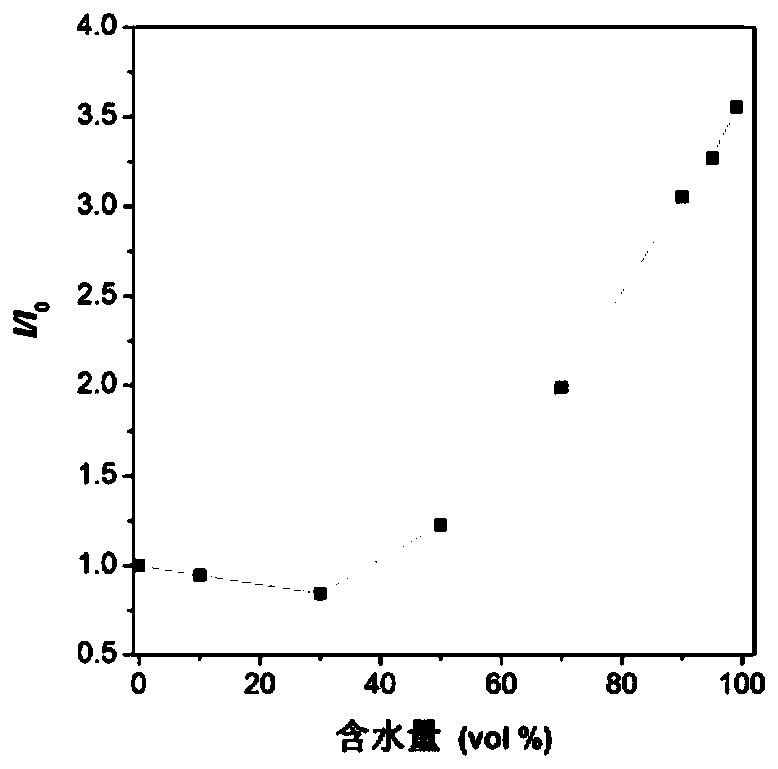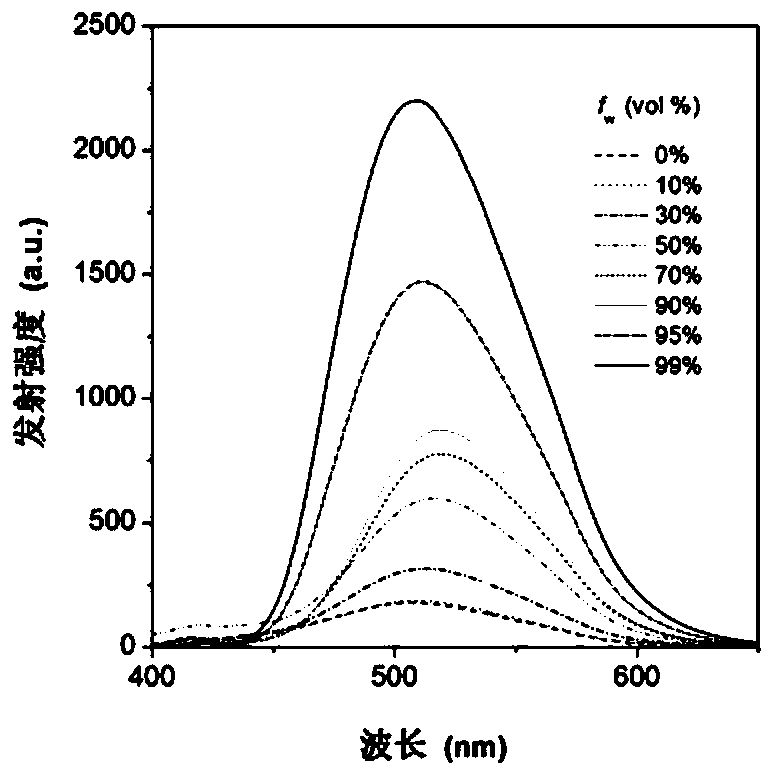A class of spectrally tunable aggregation-induced luminescence fluorescent materials and their preparation methods and applications
A technology of aggregation-induced luminescence and fluorescent materials, which is applied in the application field of labeling mitochondria, can solve the problems of fluorescence quenching and low solid quantum yield, and achieve good biocompatibility, high solid-state luminescence efficiency, and significant aggregation-induced luminescence The effect of the characteristic
- Summary
- Abstract
- Description
- Claims
- Application Information
AI Technical Summary
Problems solved by technology
Method used
Image
Examples
Embodiment 1
[0046] 1. Add 116.8mg (0.4mmol) 2,5-dibromobenzene-1,4-dicarbaldehyde, 1.0mL N,N-dimethylformamide, 0.5mL 2mol / L Na in a 10mL flask 2 CO 3 Aqueous solution and 190.04mg (1.0mmol) 4-trifluoromethylphenylboronic acid shown in formula I-1, stir and mix uniformly, then add 4.4mg (0.02mmol) palladium acetate, in nitrogen atmosphere, normal temperature reaction 10 hours, use Extracted with ethyl acetate, combined the organic phases, and dried with anhydrous sodium sulfate, filtered, concentrated under reduced pressure to remove the solvent, column chromatography (with a 20:1 volume ratio of petroleum ether and ethyl acetate as the eluent), 2,5-bis(4-trifluoromethylphenyl)benzene-1,4-dicarbaldehyde represented by formula II-1 was obtained.
[0047]
[0048]2. Mix 97mg (0.23mmol) 2,5-bis(4-trifluoromethylphenyl)benzene-1,4-dicarbaldehyde, 85mg (0.55mmol) 4-pyridineacetonitrile hydrochloride, 86μL (0.92mmol) Add triethylamine and 3mL ethanol to the flask, stir and react at 40°C fo...
Embodiment 2
[0054] Synthesis of aggregation-induced luminescent fluorescent materials with the following structural formula
[0055]
[0056] In this example, the 4-trifluoromethylphenylboronic acid in Example 1 was replaced with an equimolar amount of phenylboronic acid, and the other steps were the same as in Example 1 to obtain an aggregation-induced luminescent fluorescent material with a yield of 78%. The structural characterization data are: 1 H-NMR (400MHz, d 6 -DMSO) δ (ppm): 9.02 (d, J = 6.7Hz, 4H), 8.50 (s, 2H), 8.35-8.33 (m, 6H), 7.60-7.53 (m, 10H), 4.34 (s, 6H ); 13 C NMR (151MHz, d 6 -DMSO)δ(ppm): 151.20, 148.69, 146.47, 142.25, 138.13, 134.53, 131.65, 130.40, 129.80, 129.74, 124.38, 116.57, 111.64, 48.33; HRMS: m / z (M-2PF 6 ) 2+ The theoretical value is 258.1160, and the measured value is 258.1152.
Embodiment 3
[0058] Synthesize fluorescent materials with the following structural formula
[0059]
[0060] In this example, the 4-trifluoromethylbenzeneboronic acid in Example 1 was replaced with 4-methylbenzeneboronic acid in an equimolar amount, and the other steps were the same as in Example 1 to obtain a fluorescent material with a yield of 90%. The structural characterization data are: 1 H-NMR (400MHz, d 6 -DMSO)δ(ppm): 9.04(d, J=6.7Hz, 4H), 8.48(s, 2H), 8.35(d, J=6.9Hz, 4H), 8.30(s, 2H), 7.44(d, J=8.0Hz, 4H), 7.35(d, J=8.0Hz, 4H), 4.35(s, 6H), 2.39(s, 6H); 13 C NMR (151MHz, d 6 -DMSO)δ(ppm): 150.74, 147.99, 146.13, 141.18, 138.44, 134.82, 133.84, 130.90, 129.75, 129.54, 123.54, 116.03, 110.83, 47.55, 20.78; HRMS: m / z (M-2PF 6 ) 2+ The theoretical value is 272.1317, and the measured value is 272.1308.
PUM
 Login to View More
Login to View More Abstract
Description
Claims
Application Information
 Login to View More
Login to View More - R&D
- Intellectual Property
- Life Sciences
- Materials
- Tech Scout
- Unparalleled Data Quality
- Higher Quality Content
- 60% Fewer Hallucinations
Browse by: Latest US Patents, China's latest patents, Technical Efficacy Thesaurus, Application Domain, Technology Topic, Popular Technical Reports.
© 2025 PatSnap. All rights reserved.Legal|Privacy policy|Modern Slavery Act Transparency Statement|Sitemap|About US| Contact US: help@patsnap.com



